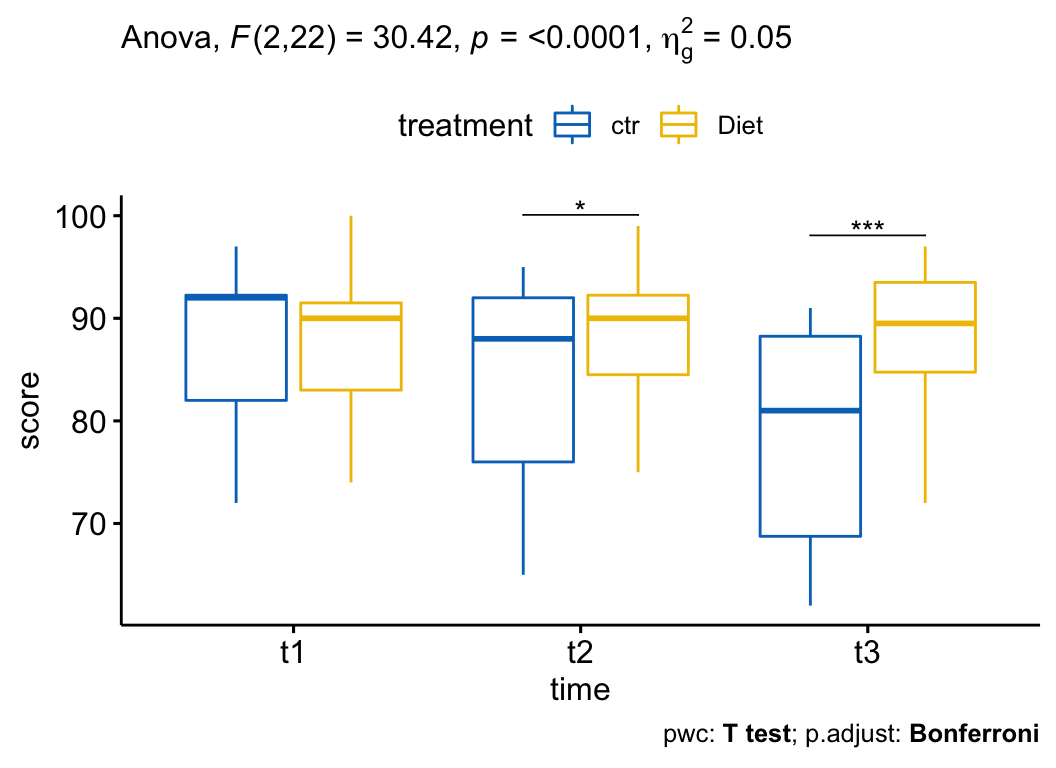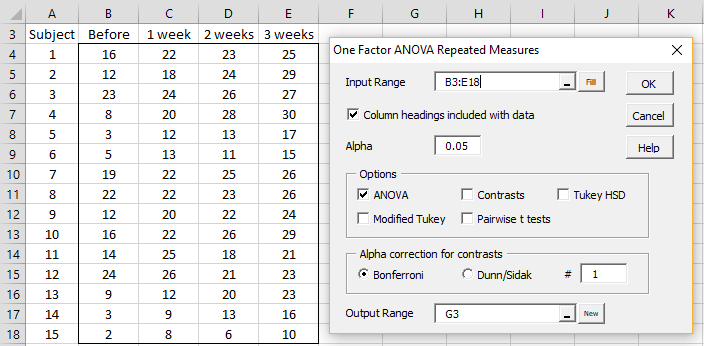How to Perform Repeated Measures ANOVA in R|2025
/in R Articles /by BesttutorLearn How to Perform Repeated Measures ANOVA in R with step-by-step guidance. Analyze within-subject data, test differences, and interpret results accurately.
Repeated Measures Analysis of Variance (ANOVA) is a statistical technique used when the same subjects are repeatedly measured under different conditions or over time. This approach is useful when dealing with data collected from the same subjects multiple times, ensuring that any variance between measurements due to different conditions can be accurately analyzed. In R, repeated measures ANOVA can be performed using various functions and packages, providing flexible options for conducting statistical analysis in a variety of research settings.
In this paper, we will explore the process of performing repeated measures ANOVA in R, including one-way, two-way, and three-way repeated measures designs. We will also demonstrate how to conduct within-subjects ANOVA in R and compare this method to other platforms like SPSS. The examples provided will guide the reader on how to implement repeated measures ANOVA in R using relevant functions.
Table of Contents
ToggleTypes of Repeated Measures ANOVA
One-Way Repeated Measures ANOVA
A one-way repeated measures ANOVA is used when there is one independent variable with multiple levels (conditions) measured within the same subjects. The purpose is to assess whether there is a significant difference in means across the different levels of the independent variable. In R, this can be performed using the aov() function, which is part of the base R package.
Example: One-Way Repeated Measures ANOVA in R
Consider a study measuring the effect of different teaching methods on students’ scores. The independent variable, “teaching method,” has three levels (Method A, Method B, Method C), and each student is tested using all three methods.
# Example data
students <- rep(1:10, each=3) # 10 students, each tested under 3 methods
method <- factor(rep(c("Method A", "Method B", "Method C"), times=10)) # Teaching methods
score <- c(80, 85, 88, 75, 80, 82, 90, 92, 94, 70, 78, 85, 88, 91, 93, 85, 86, 89, 95, 97, 85, 89, 92, 93, 98, 100, 85, 88, 90, 92)data <- data.frame(students, method, score)
anova_result <- aov(score ~ method + Error(students / method), data=data)
summary(anova_result)
In the above example, we use the Error() function to specify that the measurements are repeated within subjects, which is essential for conducting repeated measures ANOVA. The result will provide an F-value and p-value, helping us determine whether there is a significant effect of teaching method on students’ scores.
Two-Way Repeated Measures ANOVA
A two-way repeated measures ANOVA is used when there are two independent variables with multiple levels, and both factors are measured within the same subjects. This type of analysis allows researchers to assess both the main effects of each independent variable and the interaction effect between them.
Example: Two-Way Repeated Measures ANOVA in R
Imagine a study analyzing the effects of teaching method (Method A, B, C) and time (pre-test, post-test) on students’ scores.
# Example data for two-way repeated measures ANOVA
students <- rep(1:10, each=6)
method <- factor(rep(c("Method A", "Method B", "Method C"), each=2, times=10))
time <- factor(rep(c("Pre-test", "Post-test"), times=30))
score <- c(80, 85, 90, 92, 94, 98, 75, 78, 81, 86, 88, 92, 90, 92, 95, 93, 95, 97, 85, 87, 92, 94, 98, 100, 85, 90, 92, 93, 95, 100, 91, 93, 96, 99, 94, 95, 97)data <- data.frame(students, method, time, score)
anova_result_2way <- aov(score ~ method * time + Error(students / (method * time)), data=data)
summary(anova_result_2way)
Here, the model tests the interaction effect between the teaching method and time, alongside their individual main effects. The output will allow us to identify whether there are significant differences in the students’ scores due to either teaching method, time, or the interaction between both factors.
Three-Way Repeated Measures ANOVA
A three-way repeated measures ANOVA involves three independent variables, each with multiple levels. This is appropriate when researchers wish to investigate the interaction between three factors and their combined effect on the dependent variable.
Example: Three-Way Repeated Measures ANOVA in R
Imagine a scenario where researchers are studying the effects of teaching method (Method A, B, C), time (pre-test, post-test), and gender (Male, Female) on students’ scores.
# Example data for three-way repeated measures ANOVA
students <- rep(1:10, each=12)
method <- factor(rep(c("Method A", "Method B", "Method C"), each=4, times=10))
time <- factor(rep(c("Pre-test", "Post-test"), each=6, times=10))
gender <- factor(rep(c("Male", "Female"), each=12, times=5))
score <- c(80, 85, 88, 90, 92, 94, 85, 88, 89, 93, 95, 97, 75, 78, 80, 84, 86, 88, 70, 72, 74, 76, 78, 80, 85, 88, 90, 92, 91, 94, 95, 97, 78, 80, 82, 85, 87, 89)data <- data.frame(students, method, time, gender, score)
anova_result_3way <- aov(score ~ method * time * gender + Error(students / (method * time * gender)), data=data)
summary(anova_result_3way)
This model tests the three-way interaction between teaching method, time, and gender, as well as the main effects of each variable. By analyzing the output, researchers can determine the most significant factors affecting students’ scores.
Performing Repeated Measures ANOVA Online
There are several online tools and platforms available for performing repeated measures ANOVA. Some of these platforms provide easy-to-use interfaces that can be accessed without the need for programming knowledge. Examples include:
- SPSS: A powerful software for statistical analysis that allows researchers to perform repeated measures ANOVA through a graphical interface. It is widely used in social science research and provides extensive options for analyzing complex data.
- JASP: An open-source statistics software that provides a user-friendly interface for repeated measures ANOVA. It offers Bayesian statistics as well as frequentist methods.
- RStudio Cloud: RStudio’s cloud-based platform can be used to run R scripts, including repeated measures ANOVA, in an online environment. This allows users to access R and RStudio without needing to install them locally.
Repeated Measures ANOVA in SPSS
While R provides a flexible and powerful platform for repeated measures ANOVA, SPSS is another popular tool widely used in various disciplines. To perform repeated measures ANOVA in SPSS, follow these steps:
- Enter Data: Organize your data such that each condition or time point is in a separate column.
- Analyze: Navigate to the “Analyze” menu, select “General Linear Model,” and then choose “Repeated Measures.”
- Define Within-Subjects Factor: Specify the within-subjects factor (e.g., time or condition) and the number of levels.
- Add Variables: Assign the variables to the appropriate within-subjects factor.
- Run the Analysis: Click “OK” to run the analysis and view the results, which include the main effects and interactions.
Within-Subjects ANOVA in R
A within-subjects design refers to an experiment where each participant is exposed to all conditions or measurements. This type of design is a common application of repeated measures ANOVA. In R, performing within-subjects ANOVA is similar to the examples provided above, with the key difference being the focus on analyzing the differences within the same participants across conditions or time points.
# Example for within-subjects ANOVA in R
students <- rep(1:10, each=3)
condition <- factor(rep(c("Condition A", "Condition B", "Condition C"), times=10))
score <- c(80, 85, 90, 75, 78, 82, 85, 88, 90, 78, 82, 85, 80, 85, 87, 90, 92, 95, 88, 91, 94, 96, 82, 84, 87, 88, 91, 95)data <- data.frame(students, condition, score)
anova_result_within <- aov(score ~ condition + Error(students / condition), data=data)
summary(anova_result_within)
This analysis assesses whether the different conditions (e.g., Condition A, B, and C) significantly impact the scores of participants while controlling for individual differences.
Conclusion
Repeated measures ANOVA is a valuable statistical tool for analyzing data from repeated observations or measurements on the same subjects. In R, this technique can be performed using functions like aov() in one-way, two-way, and three-way designs. These designs help researchers assess the effects of one or more independent variables on a dependent variable, considering both main and interaction effects.
By understanding how to perform repeated measures ANOVA in R, researchers can gain insights into the complex dynamics between variables in within-subjects designs, contributing to a deeper understanding of their study’s phenomena. While R offers a powerful and flexible platform, alternatives like SPSS and online tools provide convenient ways to perform similar analyses.
Needs help with similar assignment?
We are available 24x7 to deliver the best services and assignment ready within 3-4 hours? Order a custom-written, plagiarism-free paper





